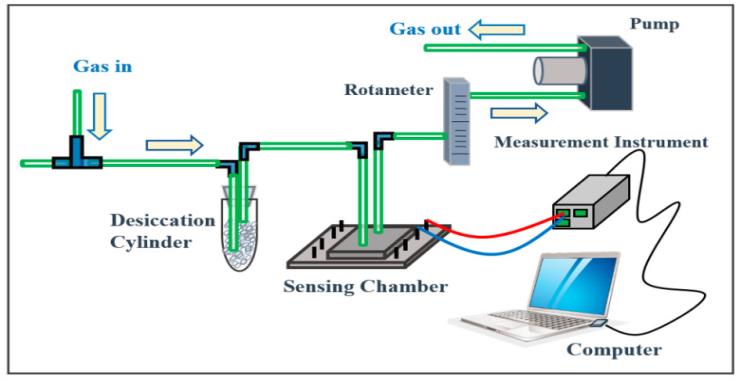
-

-
-
The sensing system includes a desiccation cylinder, an airtight sensing chamber, a rotameter, a pump, and an electrical signal measurement instrument (Keysight U2722A USB Modular Source Measure Unit).
Chronic kidney disease (CKD) is a public health problem and its prevalence has increased worldwide; patients are commonly unaware of the condition. The present study aimed to investigate whether exhaled breath ammonia via vertical-channel organic semiconductor (V-OSC) sensor measurement could be used for rapid CKD screening. We enrolled 121 CKD stage 1–5 patients, including 19 stage 1 patients, 26 stage 2 patients, 38 stage 3 patients, 21 stage 4 patients, and 17 stage 5 patients, from July 2019 to January 2020. Demographic and laboratory data were recorded. The exhaled ammonia was collected and rapidly measured by the V-OSC sensor to correlate with kidney function. Results showed no significant difference in age, sex, body weight, hemoglobin, albumin level, and comorbidities in different CKD stage patients. Correlation analysis demonstrated a good correlation between breath ammonia and blood urea nitrogen levels, serum creatinine levels, and estimated glomerular filtration rate (eGFR). Breath ammonia concentration was significantly elevated with increased CKD stage compared with the previous stage (CKD stage 1/2/3/4/5: 636 ± 94; 1020 ± 120; 1943 ± 326; 4421 ± 1042; 12781 ± 1807 ppb, p < 0.05). The receiver operating characteristic curve analysis showed an area under the curve (AUC) of 0.835 (p < 0.0001) for distinguishing CKD stage 1 from other CKD stages at 974 ppb (sensitivity, 69%; specificity, 95%). The AUC was 0.831 (p < 0.0001) for distinguishing between patients with/without eGFR < 60 mL/min/1.73 m2 (cutoff 1187 ppb: sensitivity, 71%; specificity, 78%). At 886 ppb, the sensitivity increased to 80% but the specificity decreased to 69%. This value is suitable for kidney function screening. Breath ammonia detection with V-OSC is a real time, inexpensive, and easy to administer measurement device for screening CKD with reliable diagnostic accuracy.